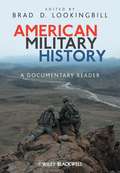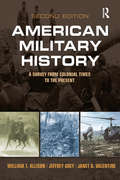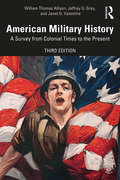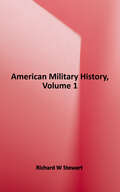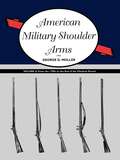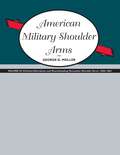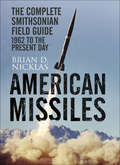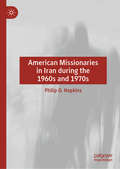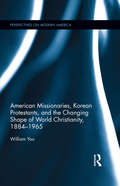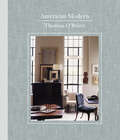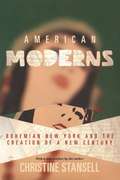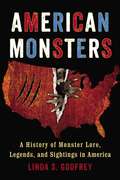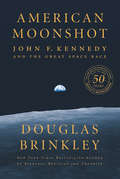- Table View
- List View
American Military History: A Documentary Reader
by Brad D. LookingbillAmerican Military History: A Documentary Reader presents a comprehensive collection of primary documents relating to America's armed forces from the colonial period to the present. Features documents which introduce key people, events, and turning points in American military history Explores the importance of events not only in terms of military history, but also on a social and cultural level for the country at large.
American Military History: A Documentary Reader
by Brad D. LookingbillA collection of primary documents that explore the many facets of the American military from the colonial period to the present The second edition of American Military History offers an exceptional collection of primary documents relating to history of the military of the United States from 1607 through the present. The writings offer insight into the armed forces in relation to the social, cultural, economic, political, and territorial development of the United States. Several documents comment on strategic initiatives, combat operations, force structure, public policy, and home fronts. The writings also present firsthand testimony of extraordinary men and women in uniform and most of the documents explore the connections between combatants and the societies that produced them. From the beginnings of the war against the natives through the tragedy of the Civil War and up to the current Global War on Terror, American Military History offers a chronological account of the evolution of the United States military. This vital text: Includes writings that explore the diversity of the armed forces Explores leadership in America’s military affairs Traces America’s ways of war beginning in 1607 through the present Examines the patterns of design and purpose of the American military over time Reveals the vitality of civil-military relations in the United States Written for academics and students of military history, American Military History is an important text that draws on primary sources to explore the many facets of America’s military history.
American Military History: A Survey From Colonial Times to the Present
by Jeffrey Grey Janet G Valentine William Thomas AllisonAmerican Military History is uniquely tailored to American military history courses. Organized chronologically, the text begins at the point of European conflict with Native Americans and concludes with military affairs in the early 21st century.The content and style will appeal to history majors and non-majors and is designed to allow instructors flexibility in the structure of their course.
American Military History: A Survey From Colonial Times to the Present
by William Thomas Allison Janet G. Valentine Jeffrey G. GreyNow in its third edition, American Military History examines how a country shaped by race, ethnicity, economy, regionalism, and power has been equally influenced by war and the struggle to define the role of a military in a free and democratic society. Organized chronologically, the text begins at the point of European conflict with Native Americans and concludes with military affairs in the early 21st century, providing an important overview of the military’s role on an international, domestic, social, and symbolic level. The third edition is fully updated to reflect recent developments in military policy and the study of military history and war and society, thus providing students a foundational understanding of the American military experience. This book will be of interest to students of American history and military history. It is designed to allow instructors flexibility in structuring a course.
American Military History: The United States Army and the Forging of a Nation, 1775-1917 (Army Historical Ser.)
by Richard Winship Stewart Center of Military History U. S. Army StaffThis latest edition of an official U.S. Government military history classic provides an authoritative historical survey of the organization and accomplishments of the United States Army. This scholarly yet readable book is designed to inculcate an awareness of our nation's military past and to demonstrate that the study of military history is an essential ingredient in leadership development. It is also an essential addition to any personal military history library. This text is used in military ROTC training courses as a basic military history textbook. Volume 1 of 2 volume set.
American Military Intervention in Unconventional War
by Wayne BertA study of the major U. S. military interventions in unconventional war, this book looks at four wars that occurred while the U. S. was a superpower in the post-war WW II period and one in the Philippines in 1898.
American Military Life In The 21st Century: Social, Cultural, And Economic Issues And Trends
by Eugenia Weiss Carl CastroAmerican Military Life in the 21st Century <P><P> Social, Cultural, and Economic Issues and Trends <P><P> VOLUME I: Active Duty Life
American Military Life In The 21st Century: Social, Cultural, And Economic Issues And Trends
by Eugenia Weiss Carl CastroAmerican Military Life in the 21st Century <P><P> Social, Cultural, and Economic Issues and Trends <P><P> VOLUME 2: Life of Military Families, National Guardsmen and Reservists, and Veterans
American Military Policy (Point Counterpoint)
by Alan Allport"The debates presented in POINT/COUNTERPOINT are among the most interesting and controversial in contemporary American society, but studying them is more than an academic activity. They affect every citizen; they are the issues that today's leaders debate and tomorrow's will decide. The reader may one day play a central role in resolving them." -Introduction
American Military Shoulder Arms, Volume I: Colonial and Revolutionary War Arms
by George D. MollerAmerican Military Shoulder Arms, Volume I: Colonial and Revolutionary War Arms focuses on the arms used from the early exploratory period throughout the colonial period and the American Revolution. Arranged chronologically, it contains definitive descriptions of the pre-flintlock and flintlock shoulder arms used in North America and detailed accounts of the development and progression of military regulation shoulder arms of the major colonial powers from the early eighteenth century through the Revolutionary War. Lavishly illustrated with more than four hundred vivid photographs of muskets, rifles, carbines, and other arms, this book offers an intelligent analysis of the shoulder arms procured and used by the colonists, colonial and state governments, and the Continental Congress.
American Military Shoulder Arms, Volume II: From the 1790s to the End of the Flintlock Period
by George D. MollerNew data surrounding the procurement and modifications of arms produced by the national armories, and under federal contract procured by the individual states and by individual members of militias, is presented here for the first time. This information, interwoven with military, political, economic, and social factors, results in new and better definitions and a clearer understanding of the arms&’ historical context. Though this work focuses on military flintlock shoulder arms, details on the federal government&’s procurement of arms for Indians during rapidly changing military policies of the period is also included. American Military Shoulder Arms, Volume II, contains more than three hundred photographs. As with the previous volume, Volume II is written primarily for students of arms, but also contains material of interest to historians, museum specialists, collectors, and dealers of antique arms.
American Military Shoulder Arms, Volume III: Flintlock Alterations and Muzzleloading Percussion Shoulder Arms, 1840-1865
by George D. MollerThis third volume in Moller&’s authoritative reference work describes muzzleloading percussion shoulder arms procured by the U.S. government for issue to federal and state armed forces in the period that includes the Civil War. These twenty-five years were an exciting time in the history of shoulder arms. During the 1840s, only a handful of American manufacturers were capable of producing significant quantities of arms having fully interchangeable components. By the early 1850s, at least one firm was producing rifles with close enough tolerances to be considered fully interchangeable. And thanks to the invention of the expanding bullet, rifled arms could be used by an army&’s entire infantry. For the first time, line infantry were equipped with arms capable of rapid reloading and of consistently hitting a man-sized target at distances as great as three hundred yards. Like the first two volumes of American Military Shoulder Arms, this exhaustive reference work will be a must for serious arms collectors, dealers, and museum specialists.
American Milling Machine Builders 1820-1920
by Kenneth L. CopeContinuing the pattern set by American Lathe Builders and American Planer, Shaper and Slotter Builders, this is the first book to identify American builders of milling machines and the products they invented circa 1818 to the development of the "modern" milling machine circa 1920. Early versions of other American machine tools were largely copied from European, especially British, machines. The milling machine, however, was an American development. Built first for the firearms and sewing machine industries, it proved to be much more productive than other methods, and soon held a major place in all high-production American machine shops. The book lists more than 300 makers and contains over 1,400 illustrations taken from original catalogs and contemporary periodicals. These trace the development of the milling machine from a crude, light weight machine to very large millers capable of machining parts the size of boxcars and weighing many tons. Attachments such as dividing heads, vises, etc., are also covered.
American Mirror: The Life and Art of Norman Rockwell
by Deborah SolomonA NEW YORK TIMES BOOK REVIEW NOTABLE BOOK OF THE YEAR A FINALIST FOR THE LOS ANGELES TIMES BOOK PRIZE IN BIOGRAPHY AND SHORTLISTED FOR THE PEN/JACQUELINE BOGRAD WELD AWARD FOR BIOGRAPHY"Welcome to Rockwell Land," writes Deborah Solomon in the introduction to this spirited and authoritative biography of the painter who provided twentieth-century America with a defining image of itself. As the star illustrator of The Saturday Evening Post for nearly half a century, Norman Rockwell mingled fact and fiction in paintings that reflected the we-the-people, communitarian ideals of American democracy. Freckled Boy Scouts and their mutts, sprightly grandmothers, a young man standing up to speak at a town hall meeting, a little black girl named Ruby Bridges walking into an all-white school—here was an America whose citizens seemed to believe in equality and gladness for all.Who was this man who served as our unofficial "artist in chief" and bolstered our country's national identity? Behind the folksy, pipe-smoking façade lay a surprisingly complex figure—a lonely painter who suffered from depression and was consumed by a sense of inadequacy. He wound up in treatment with the celebrated psychoanalyst Erik Erikson. In fact, Rockwell moved to Stockbridge, Massachusetts so that he and his wife could be near Austen Riggs, a leading psychiatric hospital. "What's interesting is how Rockwell's personal desire for inclusion and normalcy spoke to the national desire for inclusion and normalcy," writes Solomon. "His work mirrors his own temperament—his sense of humor, his fear of depths—and struck Americans as a truer version of themselves than the sallow, solemn, hard-bitten Puritans they knew from eighteenth-century portraits."Deborah Solomon, a biographer and art critic, draws on a wealth of unpublished letters and documents to explore the relationship between Rockwell's despairing personality and his genius for reflecting America's brightest hopes. "The thrill of his work," she writes, "is that he was able to use a commercial form [that of magazine illustration] to thrash out his private obsessions." In American Mirror, Solomon trains her perceptive eye not only on Rockwell and his art but on the development of visual journalism as it evolved from illustration in the 1920s to photography in the 1930s to television in the 1950s. She offers vivid cameos of the many famous Americans whom Rockwell counted as friends, including President Dwight Eisenhower, the folk artist Grandma Moses, the rock musician Al Kooper, and the generation of now-forgotten painters who ushered in the Golden Age of illustration, especially J. C. Leyendecker, the reclusive legend who created the Arrow Collar Man.Although derided by critics in his lifetime as a mere illustrator whose work could not compete with that of the Abstract Expressionists and other modern art movements, Rockwell has since attracted a passionate following in the art world. His faith in the power of storytelling puts his work in sync with the current art scene. American Mirror brilliantly explains why he deserves to be remembered as an American master of the first rank.
American Mirror: The United States and Brazil in the Age of Emancipation (America in the World #58)
by Roberto SabaHow slave emancipation transformed capitalism in the United States and BrazilIn the nineteenth century, the United States and Brazil were the largest slave societies in the Western world. The former enslaved approximately four million people, the latter nearly two million. Slavery was integral to the production of agricultural commodities for the global market, and governing elites feared the system’s demise would ruin their countries. Yet, when slavery ended in the United States and Brazil, in 1865 and 1888 respectively, what resulted was immediate and continuous economic progress. In American Mirror, Roberto Saba investigates how American and Brazilian reformers worked together to ensure that slave emancipation would advance the interests of capital.Saba explores the methods through which antislavery reformers fostered capitalist development in a transnational context. From the 1850s to the 1880s, this coalition of Americans and Brazilians—which included diplomats, engineers, entrepreneurs, journalists, merchants, missionaries, planters, politicians, scientists, and students, among others—consolidated wage labor as the dominant production system in their countries. These reformers were not romantic humanitarians, but cosmopolitan modernizers who worked together to promote labor-saving machinery, new transportation technology, scientific management, and technical education. They successfully used such innovations to improve production and increase trade.Challenging commonly held ideas about slavery and its demise in the Western Hemisphere, American Mirror illustrates the crucial role of slave emancipation in the making of capitalism.
American Misfits and the Making of Middle-Class Respectability
by Robert WuthnowHow American respectability has been built by maligning those who don't make the gradeHow did Americans come to think of themselves as respectable members of the middle class? Was it just by earning a decent living? Or did it require something more? And if it did, what can we learn that may still apply?The quest for middle-class respectability in nineteenth-century America is usually described as a process of inculcating positive values such as honesty, hard work, independence, and cultural refinement. But clergy, educators, and community leaders also defined respectability negatively, by maligning individuals and groups—“misfits”—who deviated from accepted norms.Robert Wuthnow argues that respectability is constructed by “othering” people who do not fit into easily recognizable, socially approved categories. He demonstrates this through an in-depth examination of a wide variety of individuals and groups that became objects of derision. We meet a disabled Civil War veteran who worked as a huckster on the edges of the frontier, the wife of a lunatic who raised her family while her husband was institutionalized, an immigrant religious community accused of sedition, and a wealthy scion charged with profiteering.Unlike respected Americans who marched confidently toward worldly and heavenly success, such misfits were usually ignored in paeans about the nation. But they played an important part in the cultural work that made America, and their story is essential for understanding the “othering” that remains so much a part of American culture and politics today.
American Missiles: The Complete Smithsonian Field Guide
by Brian D. NicklasThis remarkable guide provides for the first time an illustrated listing of almost 200 of Americas most powerful missiles. With information on all aspects of the missiles specifications, including the speed and capacity of the explosives used in its warhead, this book provides a comprehensive guide to the US Armys projectile hardware. 'American Missiles: The Complete Smithsonian Field Guide' draws heavily on the Herbert S. Desind Photo Collection, a resource of more than 110,000 images recently catalogued at the National Air and Space Museum. Of interest to both the specialist and the aviation enthusiasts, this book demonstrates the evolution of American missile design over the last forty years in an accessible and entertaining format.
American Missionaries in Iran during the 1960s and 1970s
by Philip O. HopkinsThis work explores the interaction of American Protestant missionaries with Iranians during the 1960s and 1970s. It focuses on the missionary activities of four American Protestant groups: Presbyterians, Assemblies of God, International Missions, and Southern Baptists. It argues that American missionaries’ predisposition toward their own culture confused their message of the gospel and added to the negative perception of Christianity among Iranians. This bias was seen primarily in the American missionaries’ desire to modernize Iran through education and healthcare, and between the missionaries’ relationship with Iranian Christians. Iranian attitudes towards missionary involvement in these areas are investigated, as is the changing American missionary strategy from a traditional method where missionaries had the final say on most matters related to American and Iranian Christian interaction, to the beginnings of an indigenous system where a partnership developed between the missionary and the Iranian Christian.
American Missionaries, Korean Protestants, and the Changing Shape of World Christianity, 1884-1965 (Perspectives on Modern America)
by William YooThis book examines the partnerships and power struggles between American missionaries and Korean Protestant leaders in both nations from the late 19th century to the aftermath of the Korean War. Yoo analyzes American and Korean sources, including a plethora of unpublished archival materials, to uncover the complicated histories of cooperation and contestation behind the evolving relationships between Americans and Koreans at the same time the majority of the world Christian population shifted from the Global North to the Global South. American and Korean Protestants cultivated deep bonds with one another, but they also clashed over essential matters of ecclesial authority, cultural difference, geopolitics, and women’s leadership. This multifaceted approach – incorporating the perspectives of missionaries, migrants, ministers, diplomats, and interracial couples – casts new light on American and Korean Christianities and captures American and Korean Protestants mutually engaged in a global movement that helped give birth to new Christian traditions in Korea, created new transnational religious and humanitarian partnerships such as the World Vision organization, and transformed global Christian traditions ranging from Pentecostalism to Presbyterianism.
American Modern
by Thomas Obrien“One of those designers whose interior and furniture designs look discovered, not created . . . both comfortable and exquisite, calm and eclectic.” —Apartment TherapyDesigner and merchant, collector and tastemaker, Thomas O’Brien has made a career of translating cool notions of modernism into an easy and generous array of modern styles that anyone can attain. Now he introduces readers to a range of those styles—from casual to formal, vintage to urban—alongside stunning photography and charming design stories.O’Brien carefully describes the design process of his chosen projects, including a downtown New York City loft, a traditional Connecticut estate, and a converted schoolhouse in eastern Long Island. Each home explores a view on the modern design spectrum he has created, as well as the individual choices that make the design unique and its mix essentially American. He explains not only what was at work to create a given style, but how readers can import those practices to their own homes and personal design sensibilities. Important design principles such as architectural authenticity, color relationships, correctness of scale, and informed collecting are threaded through a practical narrative that reads like a master class in interior design. American Modern is an inspiring design volume that will redefine the way readers think about modern interiors.“O’Brien carefully describes the design process of his chosen projects. Beautiful imagery and a unique layout describe his approach to design in a new and innovative way.” —LIFEMSTYLE“It’s like getting a glimpse into the studio paintings of a great master . . . I especially love how all of his spaces feel so gender neutral, the perfect balance.” —Cottage Farm
American Moderns: Bohemian New York and the Creation of a New Century
by Christine StansellIn the early twentieth century, an exuberant brand of gifted men and women moved to New York City, not to get rich but to participate in a cultural revolution. For them, the city's immigrant neighborhoods--home to art, poetry, cafes, and cabarets in the European tradition--provided a place where the fancies and forms of a new America could be tested. Some called themselves Bohemians, some members of the avant-garde, but all took pleasure in the exotic, new, and forbidden. In American Moderns, Christine Stansell tells the story of the most famous of these neighborhoods, Greenwich Village, which--thanks to cultural icons such as Eugene O'Neill, Isadora Duncan, and Emma Goldman--became a symbol of social and intellectual freedom. Stansell eloquently explains how the mixing of old and new worlds, politics and art, and radicalism and commerce so characteristic of New York shaped the modern American urban scene. American Moderns is both an examination and a celebration of a way of life that's been nearly forgotten.
American Monetary Policy Adjustment and Its Impacts
by Liu WeipingThis book reviews the historical evolution of U.S. monetary policy, and then uses various methods such as mathematical models and econometric analysis to study the impact of U.S. monetary policy adjustments on the domestic economy and the spillover effects on the world economy. Finally, it summarizes the challenges faced by the Chinese economy in the post financial crisis era and proposes relevant countermeasures and suggestions for China to respond to U.S. monetary policy adjustments.
American Monsters: A History of Monster Lore, Legends, and Sightings in America
by Linda S. GodfreyFrom pre-Columbian legends to modern-day eyewitness accounts, this comprehensive guide covers the history, sightings and lore surrounding the most mysterious monsters in America--including Bigfoot, the Jersey Devil, and more. Bigfoot, the chupacabra, and thunderbirds aren't just figments of our overactive imaginations--according to thousands of eyewitnesses, they exist, in every corner of the United States. Throughout America's history, shocked onlookers have seen unbelievable creatures of every stripe--from sea serpents to apelike beings, giant bats to monkeymen--in every region. Author, investigator, and creature expert Linda S. Godfrey brings the same fearless reporting she lent to Real Wolfmen to this essential guide, using historical record, present-day news reports, and eyewitness interviews to examine this hidden menagerie of America's homegrown beasts.
American Moonshot Young Readers' Edition: John F. Kennedy and the Great Space Race
by Douglas BrinkleyIn anticipation of the 50th anniversary of the first moon landing, New York Times bestselling author and historian Douglas Brinkley delivers a young readers’ edition of a story rooted in heroism, bravery, and patriotism: America’s race to the moon. July 20, 1969. It’s a day that has earned a spot in history. It’s the day that America was the first nation to succeed in sending two astronauts—Buzz Aldrin and Neil Armstrong—to the moon.But what led to this unforgettable event? What were the stakes riding on the Apollo 11’s safe landing? In acclaimed author Douglas Brinkley’s first young readers' edition, space fans will get the riveting and factual backstory of arguably the most significant achievement of the 20th century.
American Moonshot: John F. Kennedy and the Great Space Race
by Douglas BrinkleyAs the fiftieth anniversary of the first lunar landing approaches, the award winning historian and perennial New York Times bestselling author takes a fresh look at the space program, President John F. Kennedy’s inspiring challenge, and America’s race to the moon. <P><P>“We choose to go to the Moon in this decade and do the other things, not because they are easy, but because they are hard; because that goal will serve to organize and measure the best of our energies and skills, because that challenge is one that we are willing to accept, one we are unwilling to postpone, and one we intend to win.”—President John F. Kennedy <P><P>On May 25, 1961, JFK made an astonishing announcement: his goal of putting a man on the moon by the end of the decade. In this engrossing, fast-paced epic, Douglas Brinkley returns to the 1960s to recreate one of the most exciting and ambitious achievements in the history of humankind. <P><P>American Moonshot brings together the extraordinary political, cultural, and scientific factors that fueled the birth and development of NASA and the Mercury, Gemini and Apollo projects, which shot the United States to victory in the space race against the Soviet Union at the height of the Cold War. <P><P>Drawing on new primary source material and major interviews with many of the surviving figures who were key to America’s success, Brinkley brings this fascinating history to life as never before. <P><P>American Moonshot is a portrait of the brilliant men and women who made this giant leap possible, the technology that enabled us to propel men beyond earth’s orbit to the moon and return them safely, and the geopolitical tensions that spurred Kennedy to commit himself fully to this audacious dream. <P><P>Brinkley’s ensemble cast of New Frontier characters include rocketeer Wernher von Braun, astronaut John Glenn and space booster Lyndon Johnson. <P><P>A vivid and enthralling chronicle of one of the most thrilling, hopeful, and turbulent eras in the nation’s history, American Moonshot is an homage to scientific ingenuity, human curiosity, and the boundless American spirit. <P><b>A New York Times Bestseller</b>
